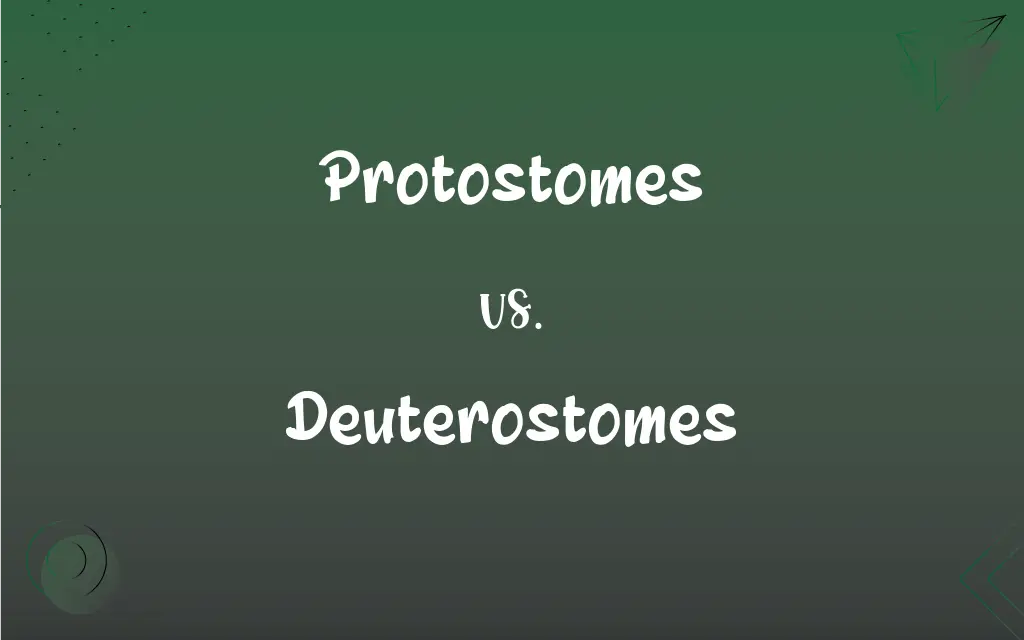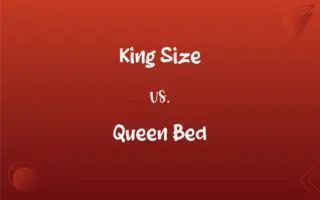Protostomes vs. Deuterostomes: What's the Difference?
Edited by Janet White || By Harlon Moss || Updated on October 4, 2023
Protostomes develop mouth first from the blastopore, while deuterostomes develop the anus first.

Key Differences
Protostomes and deuterostomes are distinguished by their embryonic development processes. In protostomes, the first opening formed during embryonic development, the blastopore, becomes the mouth. In contrast, in deuterostomes, the blastopore becomes the anus.
Among protostomes, you'll find organisms such as mollusks, annelids, and arthropods. They typically undergo spiral and determinate cleavage during embryonic development, meaning the fate of each cell is fixed early. Deuterostomes, on the other hand, include echinoderms and chordates. Their embryonic cells divide radially and indeterminately, allowing for flexibility in the development of each cell.
Body cavity formation is another distinguishing feature. Protostomes usually develop their body cavity, or coelom, by splitting a block of mesodermal cells. This is known as schizocoely. Deuterostomes, alternatively, form the coelom from outpocketings in the gut, a process termed enterocoely.
Genetic studies have provided additional insights into protostomes and deuterostomes' differences and evolutionary history. Protostomes exhibit a vast array of body plans and adaptations, whereas deuterostomes have a more consistent morphology, indicating different evolutionary pressures and histories.
Comparison Chart
Blastopore Development
Becomes the mouth
Becomes the anus
ADVERTISEMENT
Cleavage Pattern
Spiral and determinate
Radial and indeterminate
Body Cavity Formation
Schizocoely (splitting of mesodermal cells)
Enterocoely (outpocketings of the gut)
Representative Organisms
Mollusks, annelids, arthropods
Echinoderms, chordates
Genetic Diversity
Diverse body plans
More consistent morphology
Protostomes and Deuterostomes Definitions
Protostomes
Organisms exhibiting spiral, determinate cleavage.
Worms are examples of protostomes.
ADVERTISEMENT
Deuterostomes
Creatures where the anus forms before the mouth during development.
Lancelets, simple chordates, are deuterostomes.
Protostomes
Creatures developing their coelom by schizocoely.
Snails, as mollusks, fall under protostomes.
Deuterostomes
Animals forming their coelom via enterocoely.
Sea cucumbers, being echinoderms, are categorized as deuterostomes.
Protostomes
Animals where the blastopore becomes the mouth.
Arthropods are a group of protostomes.
Deuterostomes
Organisms showing radial, indeterminate cleavage.
Chordates, including humans, are deuterostomes.
Protostomes
Animals where the mouth forms before the anus in development.
Spiders, being arthropods, are protostomes.
Deuterostomes
Animals in which the blastopore becomes the anus.
Starfish, as echinoderms, are deuterostomes.
Protostomes
Groups that diverged early in the evolution of bilaterians.
Insects are among the diverse representatives of protostomes.
Deuterostomes
Taxa that shares a common ancestor with chordates and echinoderms.
Vertebrates, a subgroup of chordates, are deuterostomes.
Protostomes
Plural of protostome
Deuterostomes
Plural of deuterostome
FAQs
What does the term "blastopore" refer to in protostomes and deuterostomes?
In protostomes, the blastopore becomes the mouth, while in deuterostomes, it becomes the anus.
Are humans protostomes or deuterostomes?
Humans, as chordates, are deuterostomes.
What kind of cleavage do protostomes exhibit during development?
Protostomes exhibit spiral and determinate cleavage.
Are the nervous systems of protostomes and deuterostomes different?
Yes, protostomes typically have a ventral nervous system, whereas deuterostomes have a dorsal nervous system.
How do deuterostomes form their body cavity?
Deuterostomes form their coelom through a process called enterocoely.
Which group, protostomes or deuterostomes, has a more diverse range of body plans?
Protostomes exhibit a wider array of body plans compared to deuterostomes.
How are the cleavage patterns different between protostomes and deuterostomes?
Protostomes have spiral and determinate cleavage, while deuterostomes have radial and indeterminate cleavage.
Why is the blastopore's fate (mouth or anus) important in distinguishing protostomes from deuterostomes?
It's a fundamental difference in their embryonic development, reflecting divergent evolutionary pathways.
How does molecular genetics support the distinction between protostomes and deuterostomes?
Genetic studies have identified distinct genetic markers and developmental genes unique to each group, reinforcing their separation.
Are there any transitional or intermediate forms between protostomes and deuterostomes?
While there are species that exhibit unique developmental patterns, there isn't a recognized "transitional" form between the two groups.
How do environmental factors impact the development of protostomes and deuterostomes?
Environmental factors, such as temperature or salinity, can influence developmental rates and patterns, but the fundamental distinctions between the two groups remain consistent.
Is it possible for a protostome to evolve into a deuterostome, or vice versa?
Evolutionarily, the two groups diverged from a common ancestor, but direct transitions from one to the other in modern species are not observed.
What is schizocoely?
Schizocoely is the process by which protostomes develop their coelom by splitting mesodermal cells.
Which organisms are commonly categorized as deuterostomes?
Echinoderms and chordates are commonly recognized as deuterostomes.
Do protostomes and deuterostomes have any similarities?
Yes, both are bilaterally symmetrical during some stage of their life and belong to the supergroup Bilateria.
Which animals are commonly protostomes?
Mollusks, annelids, and arthropods are examples of protostomes.
Are there any exceptions to the developmental patterns of protostomes and deuterostomes?
Yes, while general patterns exist, there are species-specific variations and exceptions within both protostomes and deuterostomes.
Are echinoderms closely related to humans in terms of evolutionary lineage?
Yes, both echinoderms and humans are deuterostomes, indicating a shared evolutionary ancestor.
What significance does the distinction between protostomes and deuterostomes have in evolutionary biology?
The distinction helps in understanding the evolutionary relationships and developmental processes among major animal groups.
Do all protostomes have the same embryonic development pattern?
While there are common patterns, there can be variations among protostomes.
About Author
Written by
Harlon MossHarlon is a seasoned quality moderator and accomplished content writer for Difference Wiki. An alumnus of the prestigious University of California, he earned his degree in Computer Science. Leveraging his academic background, Harlon brings a meticulous and informed perspective to his work, ensuring content accuracy and excellence.
Edited by
Janet WhiteJanet White has been an esteemed writer and blogger for Difference Wiki. Holding a Master's degree in Science and Medical Journalism from the prestigious Boston University, she has consistently demonstrated her expertise and passion for her field. When she's not immersed in her work, Janet relishes her time exercising, delving into a good book, and cherishing moments with friends and family.































































